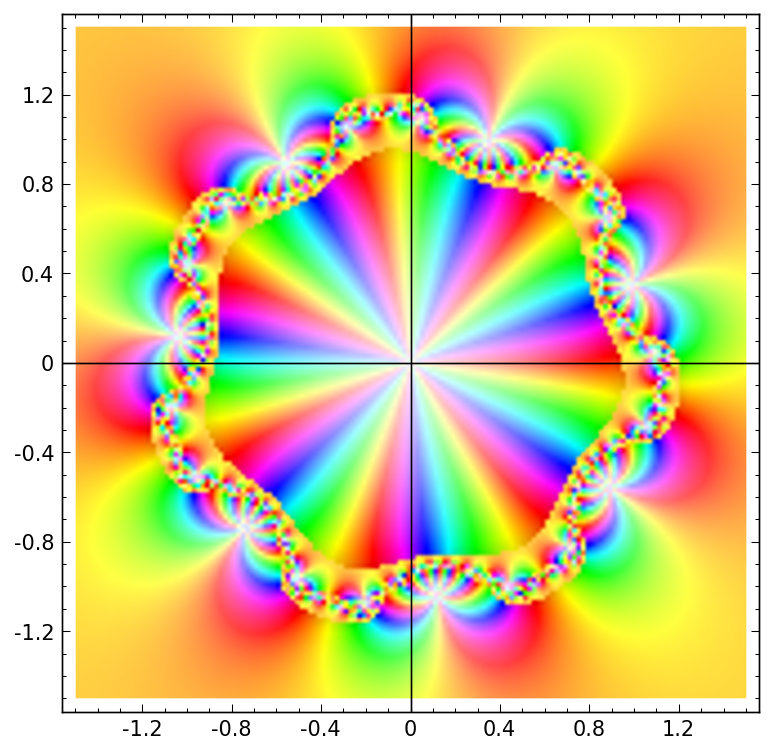|
Size: 7363
Comment: minor
|
Size: 7377
Comment: modified "exploring mandelbrot": code would not work on some machines
|
| Deletions are marked like this. | Additions are marked like this. |
| Line 137: | Line 137: |
| cdef np.ndarray[int, ndim=2] m m = np.zeros((N,N), dtype=int) |
cdef np.ndarray[np.uint16_t, ndim=2] m m = np.zeros((N,N), dtype=np.uint16) |
Sage Interactions - Fractal
goto interact main page
Contents
-
Sage Interactions - Fractal
- Mandelbrot's Fractal Binomial Distribution
- Fractals Generated By Digit Sets and Dilation Matrices (Sage Days 9 - Avra Laarakker)
- Attempt at Generating all integer vectors with Digits D and Matrix A (How about vector([0,-1])?)
- Demonstrating that the Twin Dragon Matrix is likely to yield a Tiling of a Compact Interval of R^2 as k->infinity (It does!)
- Now in 3d
- Exploring Mandelbrot
- Mandelbrot & Julia Interact with variable exponent
Mandelbrot's Fractal Binomial Distribution
def muk_plot(m0,k):
"""
Return a plot of the binomial fractal measure mu_k
associated to m0, 1-m0, and k.
"""
k = int(k)
m0 = float(m0)
m1 = float(1 - m0)
assert m0 > 0 and m1 > 0, "both must be positive"
v = [(0,0)]
t = 0
two = int(2)
delta = float(1/2^k)
multiplier = float(2^k)
for i in [0..2^k-1]:
t = i * delta
phi1 = i.str(two).count("1")
phi0 = k - phi1
y = m0^(phi0)*m1^(phi1)*multiplier
v.append((t,y))
v.append((t+delta,y))
return v
html("<h1>Mandelbrot's Fractal Binomial Measure</h1>")
@interact
def _(mu0=(0.3,(0.0001,0.999)), k=(3,(1..14)), thickness=(1.0,(0.1,0.2,..,1.0))):
v = muk_plot(mu0,k)
line(v,thickness=thickness).show(xmin=0.5, xmax=0.5, ymin=0, figsize=[8,3])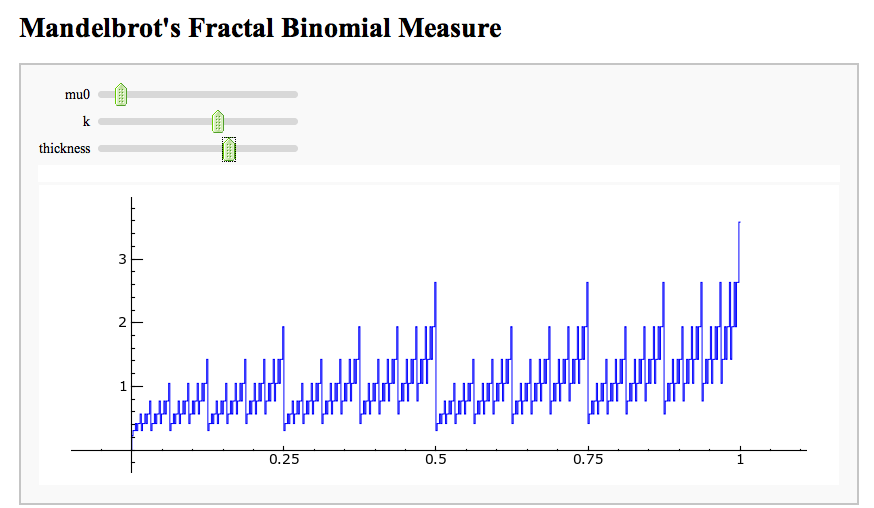
Fractals Generated By Digit Sets and Dilation Matrices (Sage Days 9 - Avra Laarakker)
Attempt at Generating all integer vectors with Digits D and Matrix A (How about vector([0,-1])?)
A = matrix([[1,1],[-1,1]])
D = [vector([0,0]), vector([1,0])]
@interact
def f(A = matrix([[1,1],[-1,1]]), D = '[[0,0],[1,0]]', k=(3..17)):
print "Det = ", A.det()
D = matrix(eval(D)).rows()
def Dn(k):
ans = []
for d in Tuples(D, k):
s = sum(A^n*d[n] for n in range(k))
ans.append(s)
return ans
G = points([v.list() for v in Dn(k)])
show(G, frame=True, axes=False)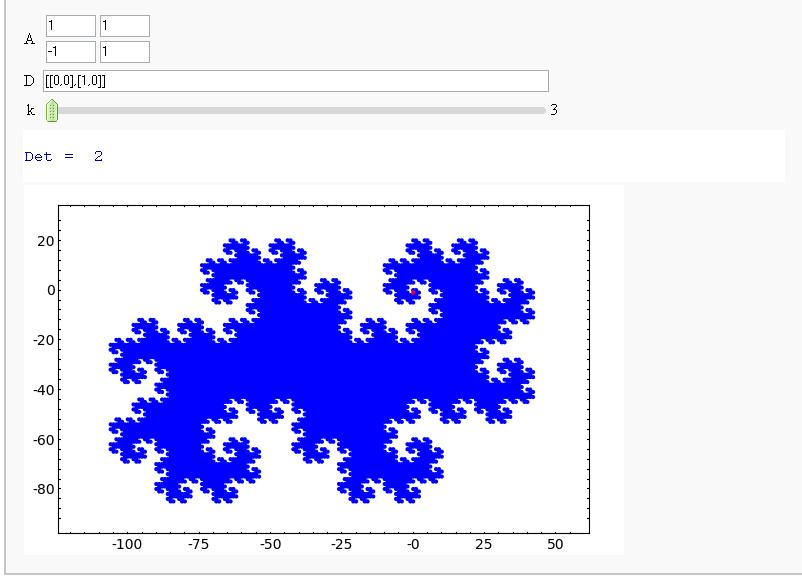
Demonstrating that the Twin Dragon Matrix is likely to yield a Tiling of a Compact Interval of R^2 as k->infinity (It does!)
A = matrix([[1,1],[-1,1]])
D = [vector([0,0]), vector([1,0])]
@interact
def f(A = matrix([[1,1],[-1,1]]), D = '[[0,0],[1,0]]', k=(3..17)):
print "Det = ", A.det()
D = matrix(eval(D)).rows()
def Dn(k):
ans = []
for d in Tuples(D, k):
s = sum(A^(-n)*d[n] for n in range(k))
ans.append(s)
return ans
G = points([v.list() for v in Dn(k)])
show(G, frame=True, axes=False)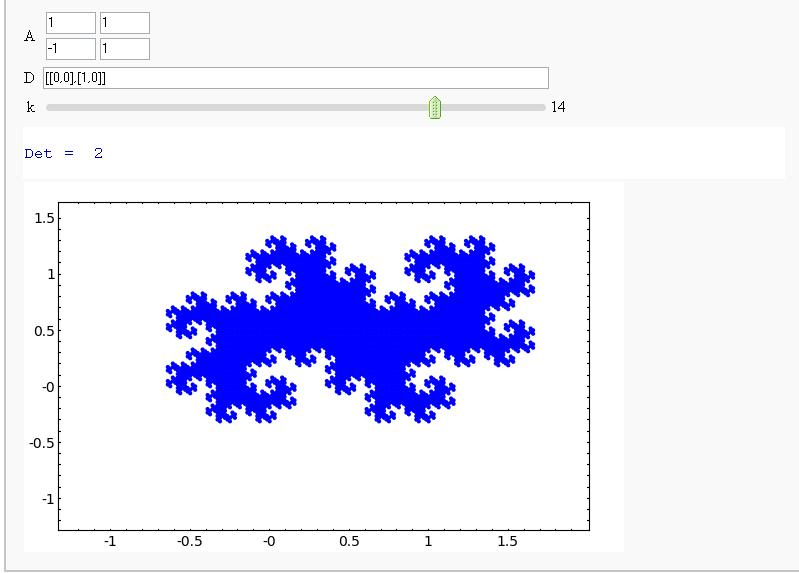
Now in 3d
A = matrix([[0,0,2],[1,0,1],[0,1,-1]])
D = '[[0,0,0],[1,0,0]]'
def Dn(D,A,k):
ans = []
for d in Tuples(D, k):
s = sum(A^n*d[n] for n in range(k))
ans.append(s)
return ans
@interact
def f(A = matrix([[0,0,2],[1,0,1],[0,1,-1]]), D = '[[0,0,0],[1,0,0]]', k=(3..15), labels=True):
print "Det = ", A.det()
D = matrix(eval(D)).rows()
print "D:"
print D
G = point3d([v.list() for v in Dn(D,A,k)], size=8)#, opacity=.85)
if labels:
G += sum([text3d(str(v),v) for v in Dn(D,A,k)])
show(G, axes=False, frame=False)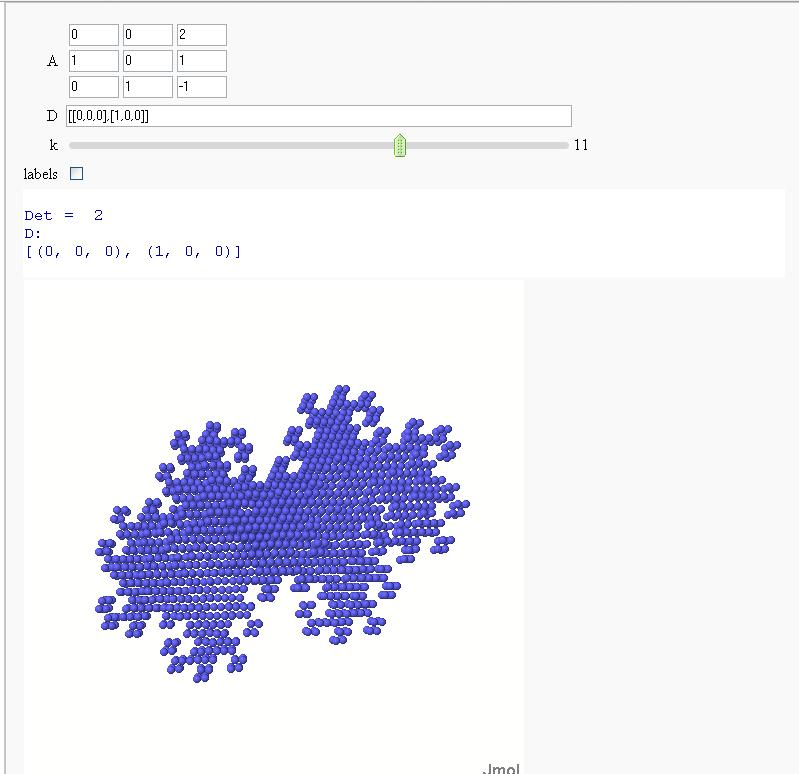
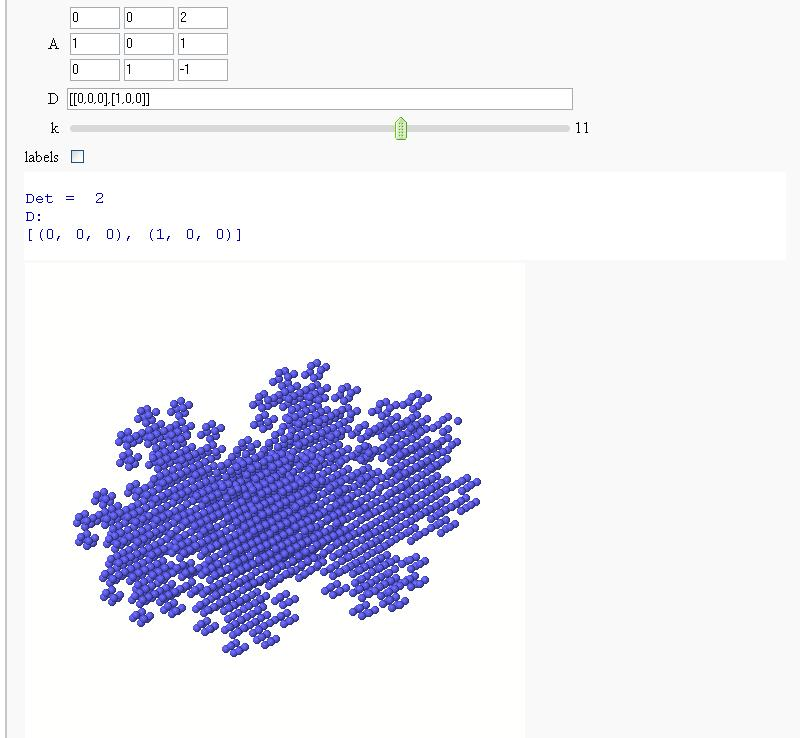
Exploring Mandelbrot
Pablo Angulo
%cython
import numpy as np
cimport numpy as np
def mandelbrot_cython(float x0,float x1,float y0,float y1,
int N=200, int L=50, float R=3):
'''returns an array NxN to be plotted with matrix_plot
'''
cdef double complex c, z, I
cdef float deltax, deltay, R2 = R*R
cdef int h, j, k
cdef np.ndarray[np.uint16_t, ndim=2] m
m = np.zeros((N,N), dtype=np.uint16)
I = complex(0,1)
deltax = (x1-x0)/N
deltay = (y1-y0)/N
for j in range(N):
for k in range(N):
c = (x0+j*deltax)+ I*(y0+k*deltay)
z=0
h=0
while (h<L and
z.real**2 + z.imag**2 < R2):
z=z*z+c
h+=1
m[j,k]=h
return mimport pylab
x0_default = -2
y0_default = -1.5
side_default = 3.0
side = side_default
x0 = x0_default
y0 = y0_default
options = ['Reset','Upper Left', 'Upper Right', 'Stay', 'Lower Left', 'Lower Right']
@interact
def show_mandelbrot(option = selector(options, nrows = 2, width=8),
N = slider(100, 1000,100, 300),
L = slider(20, 300, 20, 60),
plot_size = slider(2,10,1,6),
auto_update = False):
global x0, y0, side
if option == 'Lower Right':
x0 += side/2
y0 += side/2
elif option == 'Upper Right':
y0 += side/2
elif option == 'Lower Left':
x0 += side/2
if option=='Reset':
side = side_default
x0 = x0_default
y0 = y0_default
elif option == 'Stay':
pass
else:
side = side/2
time m=mandelbrot_cython(x0 ,x0 + side ,y0 ,y0 + side , N, L )
# p = (matrix_plot(m) +
# line2d([(N/2,0),(N/2,N)], color='red', zorder=2) +
# line2d([(0,N/2),(N,N/2)], color='red', zorder=2))
# time show(p, figsize = (plot_size, plot_size))
pylab.clf()
pylab.imshow(m, cmap = pylab.cm.gray)
time pylab.savefig('mandelbrot.png')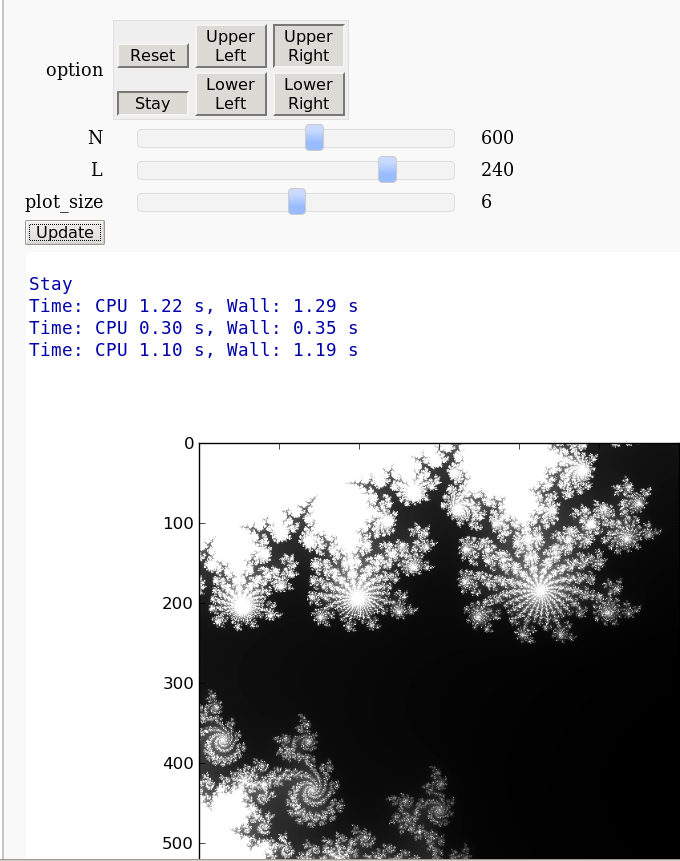
Mandelbrot & Julia Interact with variable exponent
published notebook: http://sagenb.org/pub/1299/
Mandelbrot
by Harald Schilly
@interact
def mandel_plot(expo = slider(-10,10,0.1,2), \
formula = list(['mandel','ff']),\
iterations=slider(1,100,1,30), \
zoom_x = range_slider(-2,2,0.01,(-2,1)), \
zoom_y = range_slider(-2,2,0.01,(-1.5,1.5))):
var('z c')
f(z,c) = z^expo + c
ff_m = fast_callable(f, vars=[z,c], domain=CDF)
# messing around with fast_callable
for i in range(int(iterations)/3):
f(z,c) = f(z,c)^expo+c
ff = fast_callable(f, vars=[z,c], domain=CDF)
def mandel(z):
c = z
for i in range(iterations):
z = ff_m(z,c)
if abs(z) > 2:
return z
return z
print 'z <- z^%s + c' % expo
# calling ff three times, otherwise it fast_callable exceeds a recursion limit
if formula is 'ff':
func = lambda z: ff(ff(ff(z,z),z),z)
elif formula is 'mandel':
func = mandel
complex_plot(func, zoom_x,zoom_y, plot_points=200, dpi=150).show(frame=True, aspect_ratio=1)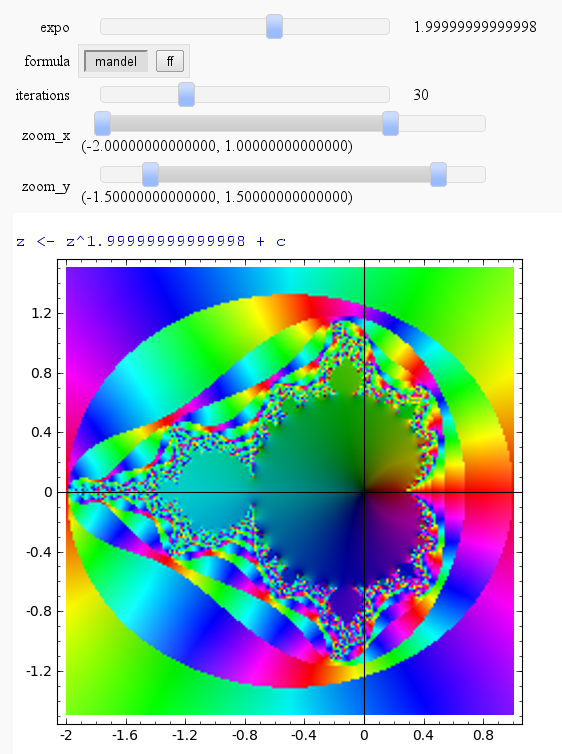
Julia
by Harald Schilly
@interact
def julia_plot(expo = slider(-10,10,0.1,2), \
iterations=slider(1,100,1,30), \
c_real = slider(-2,2,0.01,0.5), \
c_imag = slider(-2,2,0.01,0.5), \
zoom_x = range_slider(-2,2,0.01,(-1.5,1.5)), \
zoom_y = range_slider(-2,2,0.01,(-1.5,1.5))):
var('z')
I = CDF.gen()
f(z) = z^expo + c_real + c_imag*I
ff_j = fast_callable(f, vars=[z], domain=CDF)
def julia(z):
for i in range(iterations):
z = ff_j(z)
if abs(z) > 2:
return z
return z
print 'z <- z^%s + (%s+%s*I)' % (expo, c_real, c_imag)
complex_plot(julia, zoom_x,zoom_y, plot_points=200, dpi=150).show(frame=True, aspect_ratio=1)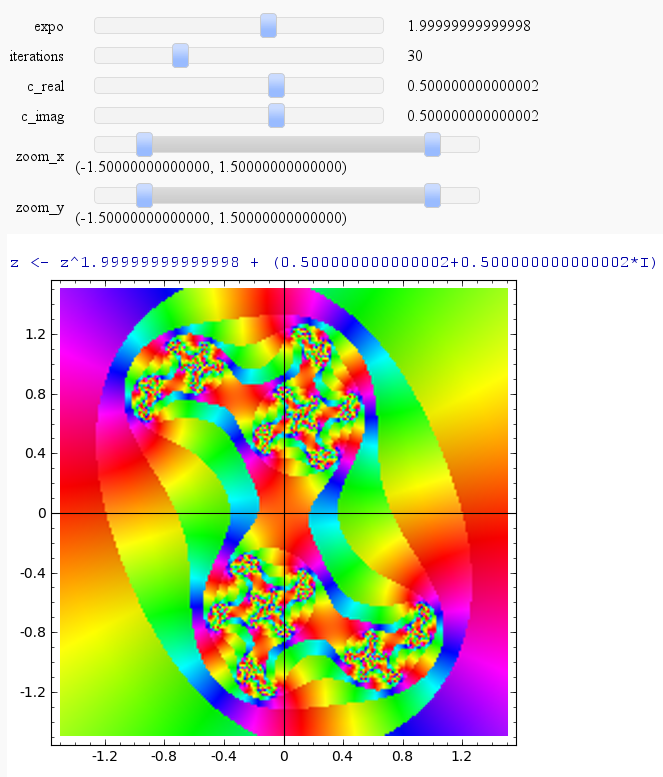
julia_plot(-7,30,0.5,0.5,(-1.5,1.5), (-1.5,1.5))
